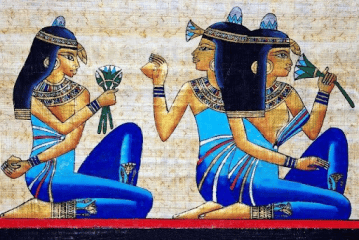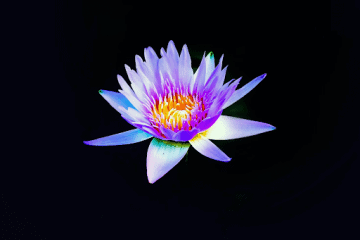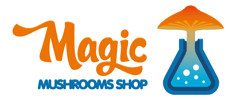The Blue Lotus and it's psychoactive and medicinal properties
Posted under: Latest News

The Blue Lotus (Nymphaea caerulea) is a sacred flower known for its mysterious allure and healing qualities. An aquatic plant native to the Nile region, it can be recognized by its vivid blue petals that bloom during the day and fold at night. This article explores the mystical blue lotus, including its historical and mythological significance, application in traditional medicine, psychoactive properties, the various ways to experience its effects, and guidance on acquiring this unique plant.
.
So, what is it?
.
The blue lotus (Nymphaea caerulea), also known as the sacred blue lily or blue Egyptian lotus, is not even a lotus, but rather a water lily that holds botanical and cultural significance. Native to parts of Africa and Southeast Asia, this aquatic plant is recognized for its striking blue flowers and has been cultivated worldwide for various purposes.
.
The blue lotus belongs to the Nymphaeaceae family and typically grows in shallow waters along the shores of ponds, lakes, and slow-moving rivers. Its distinctively vibrant blue flowers have a star-shaped configuration, measuring between 10 and 15 centimeters in diameter. The plant's leaves are broad and circular, emerging from submerged stalks connected to rhizomes.
.

..
Historical Significance, Symbolism & Mythology
....
The blue lotus flower holds cultural and historical significance in various societies where it is native including northern and central Africa, as well as select regions of Asia. The flower is commonly associated with ancient Egyptian civilization and has been depicted in art and literature on ancient papyri and tomb walls.
..
In ancient Egypt, the blue lotus was considered a symbol of creation, fertility, and rebirth. It was a key component in various ceremonies, including mourning rituals and was central to Egyptian mythology, revered as a symbol of the solar deities Amun-Ra and Atum. According to the ancient lore, the world was shrouded in darkness and water until the grand emergence of a vast blue lotus, unfurling its petals to usher in light and give rise to the inaugural gods.
..
These blue lotus flowers, blossoming in the summer, gradually ascend from the water, and unfold their petals to bask in the light of the sun. As evening falls, they gracefully close once more. As a consequence of this celestial dance, the plant took on profound significance for the ancient Egyptians, becoming a potent symbol of light (embodied by the Sun), origin, eternity, and resurrection.
..
They also understood that it has various medicinal and psychoactive properties. The flower played a role in religious and shamanistic rituals, where it was used to create a beverage, when steeped in wine, that produced trance and altered states of consciousness. The blue lotus has also been mentioned in other cultures, including ancient Greek and Roman civilizations, where it was associated with relaxation and altered states of consciousness.
.
Health Benefits & Psychoactive Properties
.

....
It is best to start with a small dose and gradually increase as a way of measuring your unique reaction to the plant and avoid potential side effects. The blue lotus flower can be prepared and consumed in many ways:
....
- Vaping & Smoking: In some instances, the blue lotus has been smoked or vaporized. This method involves heating the dried flowers or extracts to release and inhale the volatile compounds. While this approach allows for a relatively rapid onset of effects, it is not as commonly practiced as tea preparation. Roll dried petals using rolling papers or adding finely ground flowers to a vaporizer.
....
- Tea: One common method of consuming the blue lotus is by preparing infusions or teas. Dried flowers or extracts are steeped in hot water to extract the bioactive compounds. The resulting infusion can be consumed for its potential mild psychoactive effects and is often appreciated for its floral flavour. Prepare blue lotus flower tea by adding one premade tea bag or 1–2 teaspoons of dried flowers to 1–2 cups (250–500 mL) of hot water. Allow it to steep for 5–10 minutes.
....
- Tincture: Tinctures and extracts of the blue lotus can be created using alcohol or other solvents to concentrate its bioactive constituents. These concentrated forms provide an alternative to teas, offering a more potent and convenient means of consumption. Take 6 to 10 drops twice daily, added to water or directly under the tongue.
....
- Massage and essential oil: While not a method of ingestion, blue lotus extracts have been utilized topically in traditional medicine for their potential skin-soothing properties. Creams or oils containing blue lotus extracts may be applied to the skin, although the scientific evidence supporting such applications is limited.
...
Note: If you’re suffering from a mental illness and are curious about using psilocybin or any other psychedelic therapy, please consult one of the relevant medical authorities first. Do not self-prescribe, it’s vital to have the right support and guidance when using psychedelics as medicine.


January 3, 2024